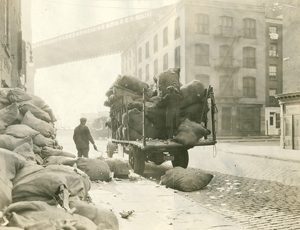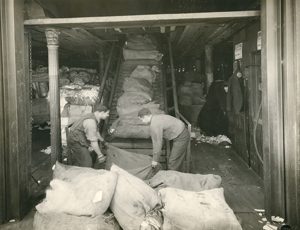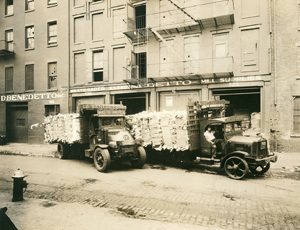The Society has assisted many members researching their family histories. Many of early 20th century US records show families involved in a business called “paper stock.” This business nurtured many from Craco and was heavily dominated by them through the mid-century. Today, the paper stock business is more recognizable under the term of “recycling” but during prior times the owners were also known as” dealers in waste paper,” and dealers in “paper mill supplies.”
Exactly how the Craceshi entered this business is unknown but an answer to the question may come from some contemporary sources at the turn of the century. Jacob Riis author of How The Other Half Lives observed in the 1880’s that, “…there is money to be made in New York’s ash-barrel, but it was left to the genius of the “padrone” to develop the full resources of the mine that was to become the exclusive preserve of the Italian immigrant.” At that time New York City hired gangs of men to trim ash scows before they were taken to sea for off-loading. Besides being paid a dollar and a half for the day they could keep whatever they found. This provided them with bones, rags, tin cans, and other waste that formed another source of revenue. Thomas Edison filmed scenes as he was developing the movie camera that include ones showing men and boys stuffing paper into burlap bags. New York City, with its heavy concentration of printing trades and office buildings was a prime location for this type of business
The 1907 New York City Directory has a business listing for 103 “Paper Stock” companies and among them are 22 names of business owners that have Crachesi roots. By 1918 White-Orr’s Reference Register listed 79 paper stock businesses in New York City, with 24 of them recognizable as Cracotans. By 1934 the business directory shrunk to 66 listings but 26 were Cracotans. So as the industry contracted over the years the Crachesi expanded their presence; going from 21% of the business owners in 1907 to 39% in 1934.
The bulk of their businesses were located in the Lower Manhattan commercial loft areas that were adjacent to the tenement neighborhood they called home. These were family businesses that sometimes included wives in roles sorting paper into different grades.

Loading Truck New York Street
The daily business cycle generally started early in the morning with trucks driving to customer locations where waste paper would be picked up. Back at the warehouse a crew would be sorting the paper into grades. After enough of a grade of paper was sorted it would be baled and stored. The baled paper would be sold to a broker who delivered it to paper mills that converted the scrap paper into new products. Paper grading was an important part of the process since price was related to the type of paper. The sorting of office waste sometime provided surprises and windfalls. Children in paper stock families always had pencils, pens and paper albeit used. But sometimes workers were more fortunate. Besides finding money or other small valuable there are also stories of individuals finding fortunes in bonds that dramatically changed their lives. After WWII changes in technology, urban redevelopment and lifestyle preferences impacted the business putting pressure on the smaller independent business owners.



